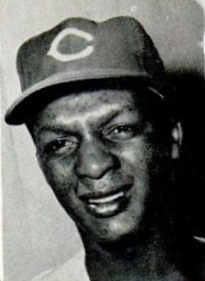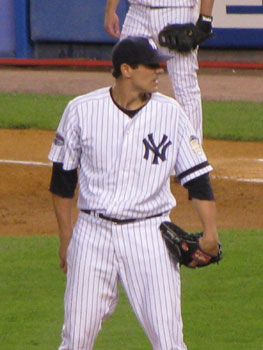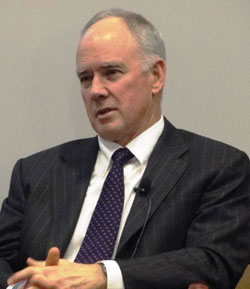By Derek Rosenfeld
From the moment certain forward-thinking entrepreneurs began charging people money to watch men and women compete in athletic events, professional sports became a business. As the years passed, the stakes became higher, the money became greater, and the responsibilities of running teams became more complex; these people needed to find more creative ways to keep the cash flowing and the turnstiles spinning while paying their “employees” as little as possible and keeping them tethered to the organization.
This began to change in the late 1960s and early 1970s when baseball’s Curt Flood (right) became the first high-profile athlete to make a major statement against the sport’s reserve clause (by refusing to accept being traded), which allowed team owners to renew players’ contracts at their own discretion for one year following the completion of a signed contract. Although he initially failed, Flood opened the door for the crucial Andy Messersmith/Dave McNally ruling of 1975 and, perhaps inadvertently, created a new competitive climate in sports where teams had to change the very way they operated in order to compete with each other.
Part 1 of my article dealt with the reliance that teams place on money and how it dictates the personnel moves that lead to its failures and successes. Spending the most does not guarantee success, although, in most cases, it is indeed necessary to at least have a shot at attaining long-term glory.
The New York Yankees are the obvious example of how spending more CAN equate to winning more, but it certainly does not mean the team will be spraying clubhouse champagne at season’s end each and every year. What it does mean that they can legitimately have a better chance than most at doing so: the team has made the Major League Baseball playoffs 16 of the past 17 years, and is better than nearly every other team at weathering the storm when a multimillion-dollar contract player busts or is lost to injury.
 For instance, for every high-priced free-agent or traded player contract that panned out (Orlando Hernandez, Hideki Matsui, Mike Mussina, Johnny Damon, Tino Martinez, CC Sabathia), the team has had just as many that have flopped. From injury-riddled Carl Pavano’s (left) four-year, $39 million contract in 2005; to Drew Henson’s six-year, $18 million deal that amounted to nine Major League at-bats; to Danny Tartabull, Jeff Weaver, Raul Mondesi, Randy Johnson, and A.J. Burnett, the Yankees’ willingness to take on nearly any and every flavor of the moment is a testament not only to their desire to win but also their deep, deep pockets. The lack of a salary cap has also contributed to the Yankees success; this is no more evident than when one watches the foibles of the other big-market New York teams.
For instance, for every high-priced free-agent or traded player contract that panned out (Orlando Hernandez, Hideki Matsui, Mike Mussina, Johnny Damon, Tino Martinez, CC Sabathia), the team has had just as many that have flopped. From injury-riddled Carl Pavano’s (left) four-year, $39 million contract in 2005; to Drew Henson’s six-year, $18 million deal that amounted to nine Major League at-bats; to Danny Tartabull, Jeff Weaver, Raul Mondesi, Randy Johnson, and A.J. Burnett, the Yankees’ willingness to take on nearly any and every flavor of the moment is a testament not only to their desire to win but also their deep, deep pockets. The lack of a salary cap has also contributed to the Yankees success; this is no more evident than when one watches the foibles of the other big-market New York teams.
The previous article briefly examined the more than decade-long struggles of the Rangers and Knicks, who seemed to model their front office policies around the Yankees’ spend-to-win mentality, which led to prolonged periods of mediocrity. The same can be said of the Jets and Mets who, despite their popularity, have made 15-20 years of high-priced, desperate moves that have resulted in years of frustration and more than a few trips to the bottom of their respective sports.
In more than 50 years of existence, the New York Jets have won one championship: their famous (or infamous) Super Bowl III victory of 1969 over the heavily favored Baltimore Colts, a victory that, led by upstart quarterback Joe Namath, essentially changed the landscape of pro football for good. Since then, the team has not inasmuch returned to the Super Bowl let alone won it. It is yet another testament to the need for front office smarts and stability that the Jets’ chief rivals, the New York Giants, have won more championships in the past four years than in the whole history of the Jets organization.
After going through 15 years of lows following the Super Bowl victory, including a disastrous 1976 campaign led by Head Coach Lou Holtz, the Jets would appear to regain life with a 1980s squad featuring rising young stars such as Ken O’Brien, Al Toon, Freeman McNeal, Wesley Walker, and the “New York Sack Exchange” (Joe Klecko and Mark Gastineau). However, the team would fail in its attempts to win, and by 1999, the Jets had hired a succession of in-demand coaches such as Bruce Coslet, Pete Carroll, Rich Kotite (who led the Jets to a 4-28 record from 1995-96), and Bill Parcells. Parcells briefly led a resurgence for the team from 1997-1999 and is the only head coach in Jets history to leave the team with a winning record (29-19). During those years, the additions of star players such as Curtis Martin, Ronnie Lott, Art Monk, Boomer Esiason, Neil O’Donnell, and a succession of poor drafts failed to improve the team, keeping them stuck behind their AFC East competition for the remainder of the decade and beyond.
Although new Head Coach Rex Ryan (right) has brought a winning mentality to the organization since taking over in 2009, he and General Manager (GM) Mike Tannenbaum have squandered the team’s upswing of back-to-back AFC Championship game appearances by refusing to maintain certain integral pieces of the roster that got them there, instead replacing those players such as Shaun Ellis, Thomas Jones, and Brad Smith with highly talented and popular but expensive players with questionable character like Santonio Holmes, Plaxico Burress (right), and Antonio Cromartie. The result this past season was an 8-8 record and a fractured, dysfunctional locker room, causing numerous off-the-field headlines and finger pointing.
Perhaps the most glaring example of how a front office can affect a professional sports team is the New York Mets. Recently celebrating the 50th anniversary of their first game, the team has won two championships in that time, the last in 1986. Almost immediately after the champagne had been popped on that title, the team was sold to one of its minority shareholders, real estate developer Fred Wilpon, and his son, Jeff.
Since then, the team has been a model of inconsistency and buffoonery and, unsurprisingly, has participated in only one World Series (2000). In those 26 years since 1986, the team has developed only a small handful of legitimate homegrown stars such as David Wright and Jose Reyes (who bolted to join the Miami Marlins this year). The front office has attempted to counter its inability to develop its own by signing or trading for big-money free agents such as Bobby Bonilla, Kevin McReynolds, Bret Saberhagan, Vince Coleman, Pedro Martinez, Mike Piazza, Carlos Beltran, Shawn Green, Johan Santana, and Jason Bay, among others, with little or no success.
 Currently, the Mets are loaded with marginal major and minor league talent. They have since hired former Oakland A’s Executive Sandy Alderson (left) and Toronto Blue Jays GM J.P. Riccardi to fix this decades-long drought. Through inconsistent play, poor player development, and even worse front office decisions, the Mets have become the irrefutable proof that a big market and a large ball of money does not automatically translate to sports glory.
Currently, the Mets are loaded with marginal major and minor league talent. They have since hired former Oakland A’s Executive Sandy Alderson (left) and Toronto Blue Jays GM J.P. Riccardi to fix this decades-long drought. Through inconsistent play, poor player development, and even worse front office decisions, the Mets have become the irrefutable proof that a big market and a large ball of money does not automatically translate to sports glory.
What may appear on the surface as being nothing more than the result of rampant spending, the Yankees success has shown that finances are simply the largest part of a bigger puzzle. Despite the team’s insistence on signing the biggest and most expensive talent, they have also had their share of positive player development over the decades with the likes of Derek Jeter, Mariano Rivera, Jorge Posada, Andy Pettitte and up-and-coming stars such as Brett Gardner and David Robertson.
Accordingly, the Yankees have placed themselves in a position where they now MUST compete for a championship every year. This also raises questions about baseball’s need to implement its own salary cap and change the rules on disclosure practices that affords teams the right to hide any and all profits from fans and lawmakers (see the Miami Marlins and the Kansas City Royals). Indeed, what happens when the Yankees have made the playoffs 90 times in the next 100 years?
For the past 20 years, the Pirates have languished at the bottom of the baseball heap, while the Steelers have been one of the best and winningest organizations in all of sports. Does this simply have to do with sheer dollar amounts, or is it all about how the wealth is spread? How can small market losers and big market winners exist in the same city? To many sports owners, winning is secondary; profits are still easily and routinely turned despite never having won a thing. As a result, being a fan of a perennial loser means being at the mercy of the front office, not the players on the field.
Photos found on Wikimedia Commons courtesy of, from top to bottom, Baseball Digest, UCinternational, Marianne O’Leary, and Chamber of Fear.
 Derek Rosenfeld is an associate editor for Fire Engineering. He has coached baseball at the collegiate level for eight seasons, including stints at New Jersey’s Bergen Community College and Ramapo College. He has also been an infielder in several highly competetive semipro baseball leagues throughout the New York tri-state area.
Derek Rosenfeld is an associate editor for Fire Engineering. He has coached baseball at the collegiate level for eight seasons, including stints at New Jersey’s Bergen Community College and Ramapo College. He has also been an infielder in several highly competetive semipro baseball leagues throughout the New York tri-state area.
During the mid-90s, Rosenfeld was a three-year starter at second base for the Ramapo College baseball team in Mahwah, New Jersey, where he earned all-New Jersey Athletic Conference honors and was a two-time New Jersey Collegiate Baseball Association (NJCBA) all-star selection. He was named MVP of the 1997 NJCBA All-Star Game. He has a bachelor’s degree in communications from Ramapo College.


